Once Again the Catalina Sky Survey Discovers an Earth-Impacting Asteroid
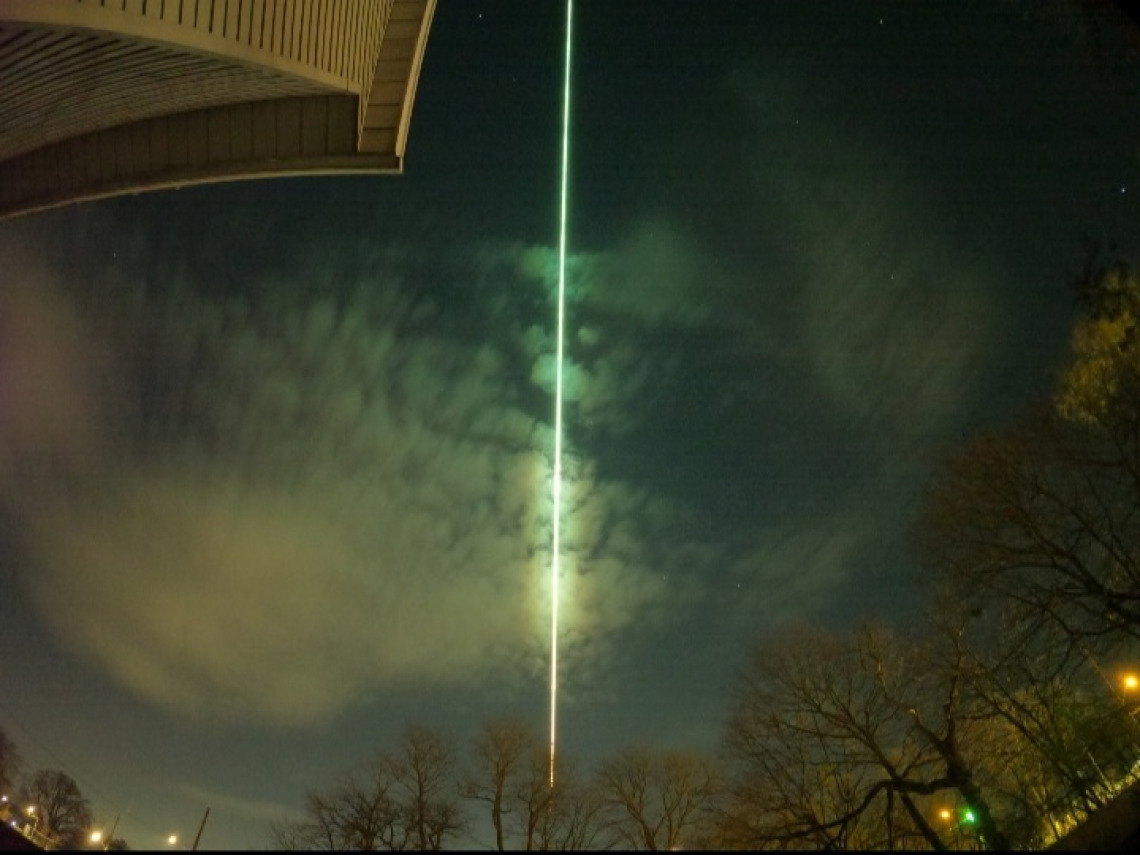
Asteroid 2022 WJ1 captured as it passed over Brantford Ontario
Dereck Bowen
At 3:27am local time in the wee hours of November 19, 2022, folks in the greater Toronto, Ontario region were jarred awake by a bright skyward flash of light, rippling sonic booms, and even some reported ground shaking. The cause this pre-dawn ruckus occurred as a small asteroid ended its space-borne travels by slamming into the Earth’s atmosphere near the southern Great Lakes region, Canada. Fortunately, the asteroid impact was harmless as the 1-meter sized space rock disintegrated during its fiery passage through the atmosphere, perhaps dropping some small fragments to the Earth’s surface near the southern shores of Lake Ontario.
As startling as this nocturnal intruder was to people in the region is the fact that it was discovered only 3 ½ hours earlier by astronomer David Rankin of the University of Arizona’s Catalina Sky Survey (CSS) near Tucson, Arizona. Rankin’s positional information of the object, derived from images acquired at the Mt Lemmon Observatory’s 1.5-meter reflecting telescope, were systematically ingested by the NASA-sponsored Scout project. Within minutes, Scout’s automated systems rapidly computed a preliminary orbit for the object and with subsequent observations Scout provided increasingly accurate details on the impact probability, and the trajectory and location of impact. Within 30 minutes of Rankin’s discovery images, additional observations indicated a 50% impact probability; and within an hour’s time further measurements by Catalina Sky Survey astronomers, and from other independent observers indicated a 100% probability. Independent observations included those submitted by a vigilant and experienced group of amateur astronomers at Farpoint Observatory, located in Eskridge, Kansas. Inclusion of their observations allowed for sufficient parallax from the discovery location to markedly constrain the trajectory of the impactor and narrow down the impact location.
The impacting asteroid, posthumously designated ‘2022 WJ1’ by Harvard University’s Minor Planet Center is only the 6th asteroid in history to be discovered before impact, four of which were discovered by the Catalina Sky Survey. In fact, the first three pre-impact asteroids were discovered by CSS astronomer Richard Kowalski in 2008, 2014, and 2018 respectively. Each of these three asteroids was also small and impacted harmlessly.
The tale of ‘2022 WJ1’ is one of high technical and programmatic success for testing NASA’s planetary defense capabilities in that the object was successfully discovered and tracked, its orbit and impact probabilities rapidly calculated and the time and location of impact accurately predicted. One might wonder why there was such a short time between discovery and impact; the reason being that this asteroid was tiny. Very small Earth-impacting asteroids the size of ‘2022 WJ1’ are rather common, striking the atmosphere once or twice a month on average. Most go undetected because being very small they reflect little light, and therefore must be close to earth for survey telescopes to spot them. Fortunately, asteroids of this size harmlessly disintegrate in the earth’s atmosphere, typically over remote regions of Earth where they go unobserved. This however is the first of the 6 pre-discovered impacting asteroids that entered the atmosphere above a heavily populated region, over the greater Toronto, Ontario area, where many security and street cameras, and a few alerted camera-ready citizens were able to capture portions of its fiery demise.
Asteroid 2022 WJ1 streaking behind Toronto’s iconic CN Tower
It is the population of larger asteroids, greater than about 140-meters in size that are of highest interest for NASA’s near-Earth asteroid surveys, like CSS. While impacts from asteroids of this size and larger are very low-probability events across the span of a human lifetime, they have occurred repeatedly over deeper time, and can do so again. As of early 2023, there are more than 31,000 discovered near-Earth asteroids, more than 10,000 of these larger than 140m. Although, none of these asteroids poses an impact threat to Earth in the next couple hundred years or more, tens of thousands more remained to be discovered. Fortunately, under the auspices of NASA’s Planetary Defense Coordination Office projects like the Catalina Sky Survey, JPL’s Scout project, and the Minor Planet Center coordinate to discover and track near-Earth asteroids, plot orbits, and to calculate impact probabilities and trajectories.
More recently NASA has successfully deployed space-based missions such as the Double Asteroid Redirect Test (DART) project to begin testing mitigation strategies for deflecting an asteroid from Earth’s path if one were discovered. In the meanwhile, discovering and tracking harmless asteroid impacts such as 2022 WJ1 provide an excellent opportunity to gauge and improve upon NASA’s planetary defense system response.
Let´s hear from now from David Rankin, the discoverer of impactor 2022 WJ1 and what he has to say about the discovery, and about his background in astronomy and science (questions by Kacper Wierzchos).
David, you discovered impactor 2022 WJ1, but it's been a long way to get where you are. When and how was your first encounter with astronomy?
I grew up at the foot of the Grand Staircase Escalante National Monument in Utah. It is a very remote area and has some of the darkest skies in the United States. On a clear dark night, it can feel like you will fall off the face of the Earth into space. Growing up under such dark skies sparked an interest in astronomy from a fairly young age. I recall an incident that happened in my preteen years. A friend and I were hiking through the desert at night to scare a local group of peers that were out camping, as we considered this fun. It was a pitch-black night and suddenly the entire sky turned brilliant white, so bright it blinded both of us for a few moments. When we turned around there was a visible area in the sky to our south that was still glowing from the bolide that had just exploded. It was a shocking experience that really scared both of us and stuck with me. I also recall seeing Hale-Bopp in the sky as a kid and being very fascinated by that.
I had an interest in the night sky but didn’t act on it until early 20s. I was surfing the web and came across a story about the outburst of Comet 17P/Holmes in 2007. The article said comet Holmes had a massive outburst, and the coma had grown larger than the sun. The comet was briefly the largest object in the solar system. I found this fascinating so I searched online how to build a telescope. At the time I had little financial means. Working with my older brother, we built two open truss Newtonian telescopes from water main pipes and spare parts with some cheap 8-inch mirrors we purchased online. This provided some really nice views of the outburst of 17P before it ended. At this point I was completely hooked on astronomy. Soon after viewing the outburst of 17P I attached a DSLR up to the telescope and discovered deep space astrophotography. This led down a rabbit hole that ended with hunting asteroids.
In some ways, you are a Renaissance Man with interests in many areas. Can you tell us more about your other interests?
As a city kid, moving to the middle of the desert was like moving to a different planet. I fell in love with all of the natural resources around the town. My friends and I spent most of our free time out exploring the desert, climbing around in canyons, and discovering things. This fostered quite a few interests that stick with me today.
I have a deep appreciation for the annual monsoon season that impacts the southwest US. I spend a lot of time out photographing storms and trying to catch flash floods on film.
I spent many years of my life looking for dinosaurs and marine reptiles in the deserts of southern Utah. I’ve been on dozens of excavations, and discovered many important sites including dinosaurs, plesiosaurs, and mammoths.
I’ve built a meteor monitoring system that shoots video of the sky 24/7 from my house in Tucson.
I have a deep interest in geology. The geology of southern UT is something to experience. So much of Earth’s history stacked in neat layers that are thousands of feet high spanning hundreds of millions of years. I completed a degree in Earth Sciences from the University of Utah in 2012. I still like to monitor earthquakes around the world from my house using a Raspberry PI powered seismograph called Raspberry Shake.
Not many people can say that they have an asteroid, a comet, and a dinosaur named after them. Can you tell us more about Eopolycotylus rankini?
I found my first plesiosaur when I was 14 years old. Like most kids, I had a fascination with dinosaurs - it just stuck with me into my teen years. I had the opportunity to work with the Museum of Northern Arizona in Flagstaff excavating plesiosaurs from the Tropic Shale in southern UT. During one outing at 16 I had stumbled upon some jaw bones of a plesiosaur. We excavated this site and realized quite a bit of the animal was there. This was published in 2007 as a new genus and species of plesiosaur. It is a tradition among paleontologists to name a new species after the discoverer. Dr. Barry Albright chose the name Eopolycotylus rankini when he published his findings.
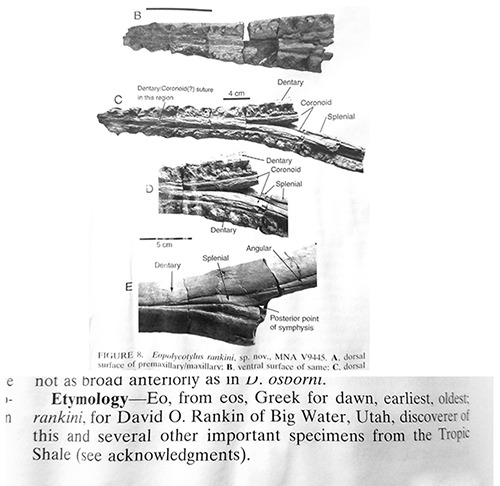
I know that you do some "flash flood independent consulting" guiding TV crews and individuals to witness a flash flood. How did your interest in flash floods start?
I think most people in the southwest United States know immediately what you mean when you say flash flood. It is such a strange juxtaposition. One minute you can be suffering from dehydration and heat exhaustion, and the next you can be taken over by a 5-foot wall of water, trees, and debris heading down a canyon from thunderstorms that hit hours before. As a kid, I would hear locals in my home town talking about these “walls of water” that would travel down the local creek. I honestly didn’t believe them. I spent a lot of time sitting at the creek waiting for flash floods so I could see for myself. I finally saw one in 2003. I eventually realized that I could better predict them using NWS radar products and Google Earth. I paid a programmer I met online $30 to write me a program that would animate the radar images in Google Earth and this increased my success rate a lot. At this point I have captured over 40 flash flood debris flows on film. I’ve been in numerous television shows and contract with production companies, typically working on nature documentaries, to help them film flash floods. They are a deadly but beautiful feature of the southwest deserts. I hope some of the footage I have captured over the years helps people understand the dangers associated with flash floods.
At CSS we have people that come from a wide range of backgrounds (computer science, engineering, astronomy, data science, geology, etc.). How did you end up working for CSS?
I was working a day job in public land management for the National Park Service. On weekends, or any clear night, I would be out with my telescope hunting and tracking asteroids. Richard Kowalski had mentioned that CSS was hiring and I should put in for a position. I honestly didn’t think I had a chance of working here but gave it a shot. At that point I had long-term plans to move to Tucson to volunteer at CSS when I could. Shortly after my wife finished college we uprooted and moved to Tucson. We both love living in this city, and greatly enjoy our new careers.
Did you know about CSS before applying for the job?
I had known about CSS for a long time before working here. My first exposure was hearing about comets named Catalina and Lemmon while running astronomy programs for the National Park Service. After getting a little worn out on astrophotography I decided to blink some images from my datasets. In that first set of images I blinked, there were 5-6 asteroids clearly visible, 2 of which I couldn’t identify. I decided to start looking for asteroids and comets around this time to see if I could discover a new one. There was a lot of discouragement, as the big surveys tend to find most new objects. At this point, as an amateur in my back yard, CSS was my direct competition. It was very difficult to find a new rock that the surveys had not observed first. I now have the pleasure of running G96, the telescope I lost many asteroid finds to.
Can you tell us more about the software that you have developed for CSS?
The first project I did for CSS was an orbit view application for plotting the orbits of minor planets and comets in an interactive way using webgl.
After gaining some experience with our software products I could see some areas where things could be automated. I wrote a program that helps us track faster asteroids using Bill Gray’s Find Orb. This was used to help track the impactor after discovery.
My last big project was creating a precovery suite that scans our archives for missed targets. This has proven to be quite successful. By extracting these missed opportunities, we get to spend less time on follow up and more time surveying. Extending the arc on newly found asteroids also helps drop the uncertainty quite a bit and potentially missed observations in the past are just as valuable as observations in the future.
I also created a pipeline using an approach developed by a friend in Germany, Daniel Bamberger. This pipeline scans the isolated tracklets file at the minor planet center for linkages between isolated single-night asteroid submissions. We have sent thousands of new identifications and extracted 7 NEOs so far.
I’m now working on integrating the wonderful software created by Daniel Parrott called Tycho-Tracker to assist with our follow up work at CSS.
As part of the night crew, you are responsible for conducting survey and/or follow up operations at night. What is the aspect of working at CSS that you enjoy the most?
While I love all aspects of this work, I especially enjoy discovering new things. It has been something that drives me for as long as I can remember. I feel like with each discovery made, I’m peering into a part of nature nobody has yet seen. There is always the chance you’ll find something spectacular. Not many people can say they work in a job like that.
When I joined CSS and I met you we had one common dream; to discover a comet. In January of 2022 you discovered comet C/2020 B3 (Rankin). Can you tell us more about the discovery and what it meant for you?
Discovering a comet was a pipe dream. I had hoped it would happen, but didn’t think it would happen. I had already discovered a few new main belt asteroids and a near-Earth Asteroid before joining the survey. I knew that when I joined CSS it was likely a matter of time before I discovered a comet. Not long after training I was surveying in skies that were heavily covered in the weeks before. While validating detections the computer system had made, I saw a fuzzy object moving very slowly in the corner of an image the software had not detected. I immediately knew it was a comet but figured it was already known. I took manual measurements and attempted to identify it. Nothing came back. That was an extremely special moment in my life I had worked towards for a long time. Looking for objects before working at the survey was much more difficult. I had no automated software to detect moving objects. I would blink and manually scan thousands of images for hours on end looking for new asteroids and comets. This helped train my eye to see them, and culminated with spotting a comet moving in CSS images the software had not detected.
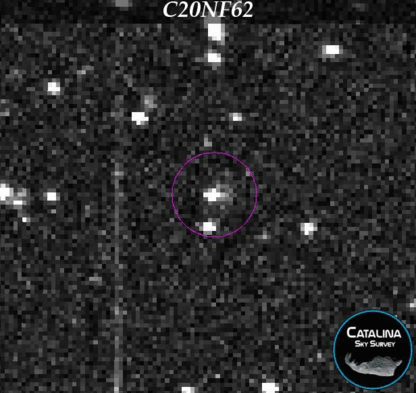
C/2020 B3 (Rankin)
When you first spotted 2022 WJ1, did you know that the object was something special when our software did not identify it as a known NEO or artificial satellite?
We see a lot of artificial satellites while surveying. Typically, NEOs, and even satellites, move in a straight line across the images over the course of 20 minutes or so. When 2022 WJ1 popped up, I could immediately tell it was making a curve towards the East. This greatly piqued my interest in the object as I knew if it was not artificial it was likely a very close approaching asteroid, or possible impactor.
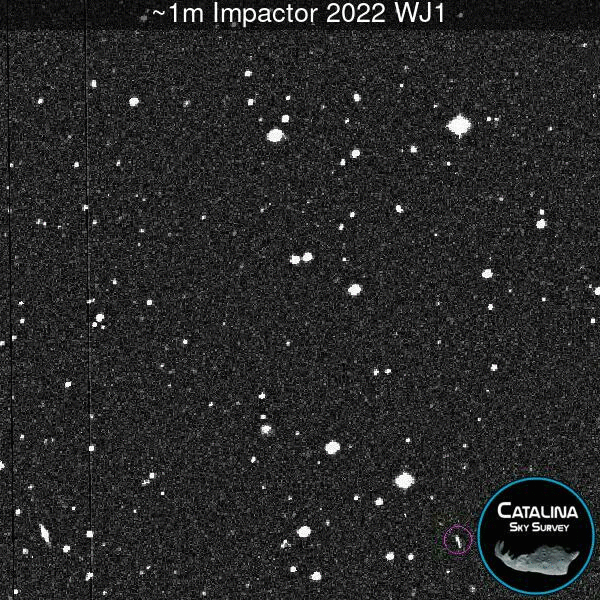
Discovery image sequence of asteroid 2022 WJ1 (Catalina Sky Survey).
Can you describe how the night of the discovery (and impact) was for you?
When it came back as a new object, I didn’t get super excited but took the necessary steps to obtain follow up astrometry as soon as possible. The initial JPL / SCOUT notice came back with a 25% probability of impact and a geocentric score of 0. At this point I knew it was either an impactor or a very close approaching NEO. By the 2nd and 3rd follow up, it was clear this was a small rock inbound with a 100% chance of hitting the atmosphere. The next few hours were definitely the most exciting moments of my career at CSS thus far. It was a bit shocking that I found the rock, realized it was an impactor, worked up until the impact, and still had many hours of surveying left in the night. Quite the roller coaster ride.
Do you consider 2022 WJ1 your most important discovery? Any other interesting objects that you found at CSS or before you joined the survey that you would like to comment?
I do think it was my most important discovery to date. Finding impactors before they hit is not an easy thing to do. This was only the sixth time in history an asteroid was spotted in space before impact. I’m extremely grateful to have taken part in this. It is nice that we get to discover objects on a nightly basis, but it was really a team of talented people that made the moment possible. I’m happy the object was quite small and posed no threat to anyone on the ground. A loud boom and a great light show was enough. At the same time, there is a larger rock out there with our name on it. Any night, any one of the CSS observers could discover that rock. That possibility is always in the back of my mind while I’m working.
In 2015 I set out with a goal of finding a comet, an asteroid, or anything new. In December of 2016 I was out freezing my tail off looking for asteroids in my back yard when I spotted a new object moving in my images. This turned out to be a new NEO. It was recently officially numbered by MPC and I was granted the rights to propose a name. I named the rock Cecily, after my wife. She is an amazing person that has been 110% supportive of this journey. I might be good at finding things, but I’d be lost without her.
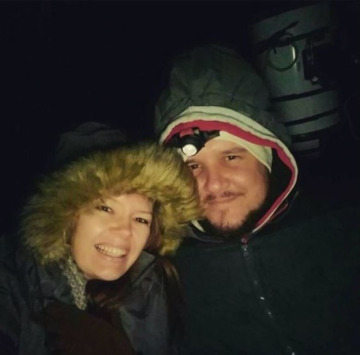
Cecily and David Rankin



